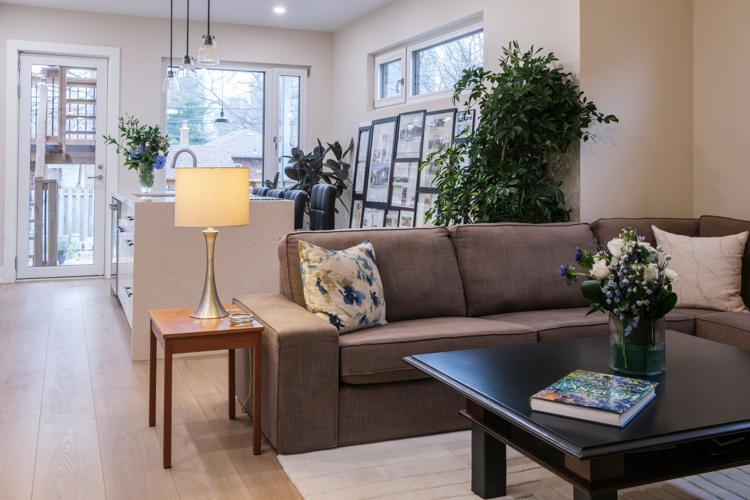Flexibility is the future of homebuilding, in Mike Manning’s view. Manning, president of Greenbilt Homes, and his wife Catherine Marshall recently downsized from a large four-bedroom single home in Oakville to a new FlexPlex in Etobicoke. As its name suggests, Manning’s brainchild is able to ‘flex’ from single large home to a duplex, triplex or fourplex.
Manning pondered how his and others’ adult children would ever be able to get into the real estate market. “I came to the conclusion that they’d need revenue as a mortgage helper, and that relates to rental properties.”
As he worked out designs, he realized his idea offered a range of solutions. “It can accommodate a multi-generation family, a co-living situation, or be a rental property that generates income.”
Manning constructed the FlexPlex on a 25-by-125 lot at 19 Burlington St. It’s currently a duplex, of two 1,800-square-foot units. Manning and Marshall have a two-bedroom unit with two offices (his in the basement and hers on the main floor), while a family rents the upper three-bedroom unit.
If Manning wants to reconfigure the building into four 900-square-foot apartments, it’s a simple renovation, as infrastructure to support that is built into the walls and floors.
The FlexPlex can accommodate up to four kitchens and eight bathrooms.
From outside, it looks like a contemporary, three-storey single-family home and it’s in a walkable neighbourhood close to restaurants, parks and amenities. Inside, it’s bright and airy. One staircase is inside the front door, and there’s an exterior staircase at the rear, with parking for two vehicles and bike storage.
“As in most rental buildings, we used the same materials and finishes throughout the whole building so we could deliver high-end finishes and still be economical,” says Manning.
You might be interested in
Stormwater reservoirs below the parking area and the front yard help divert water from the city storm sewers during rainfalls. It’s a "green" house, with no dependency on fossil fuels. Heat pumps supply heating, cooling and hot water, and Manning’s living room fireplace is electric. The house is well insulated, has triple-paned windows, and next year solar panels will be added, so it will become Net Zero, which is to say it will produce as much energy as it uses. The first month’s hydro bill, including of both units, was $205.
The FlexPlex can accommodate a homeowner throughout his or her entire life. Manning says a single person could live in one unit with a roommate, and rent out three. If they partner up and have children, they can expand their living space, then downsize when the kids leave home.
“One building can serve multiple functions,” says Manning. “Every decade could have a new scenario and it can adapt to those. If you like your neighbours and your neighbourhood, you can literally age in place and have a caregiver living in one unit.”
Janice Brooke and her husband attended a FlexPlex open house in November. Manning and Marshall rented a house across the street from Brooke in Mississauga while the FlexPlex was being built.
“Mike had told us about it, but I couldn’t conceptualize it,” says Brooke. “I was really impressed. We live in a neighbourhood with large properties, and Mississauga is talking about fourplexes.
"I was curious about what it would look like, and this took the fear away.
“This makes me hopeful for the next generation.”
Manning says the FlexPlex can be built for about $400 per square foot. His 3,800-square-foot version cost about $1.5 million, not including the lot. “If a baby-boomer couple and their adult children want to get in the market and build one of these, I’d suggest the boomers put up the financing to get it off the ground.”
The City of Toronto, the provincial and federal governments, are encouraging building of more multi-unit, residential buildings, including those in the "missing middle," which fills the gap between single family and highrise buildings.
“The general way of building in the GTA has been tall or small, and people aren’t building that missing middle typology,” says Richard Joy, executive director of the Urban Land Institute Toronto. “California has been able to get massive amounts of that type of housing supply in areas that have parks and amenities. There is absolutely enormous potential to see redevelopment of our neighbourhoods.” Land use polices and NIMBYism (people not wanting things in their neighbourhood) has caused barriers, but a lot of those have been recently removed, says Joy.
The FlexPlex was under construction prior to incentives such as development fee relief and waiving of HST for multiplexes. Manning missed out on those, but sees more FlexPlexes in his future.
“For the balance of my career, this is what I want to do,” he says. “I think we’re on to something.”





















Anyone can read Conversations, but to contribute, you should be a registered Torstar account holder. If you do not yet have a Torstar account, you can create one now (it is free).
To join the conversation set a first and last name in your user profile.
Sign in or register for free to join the Conversation